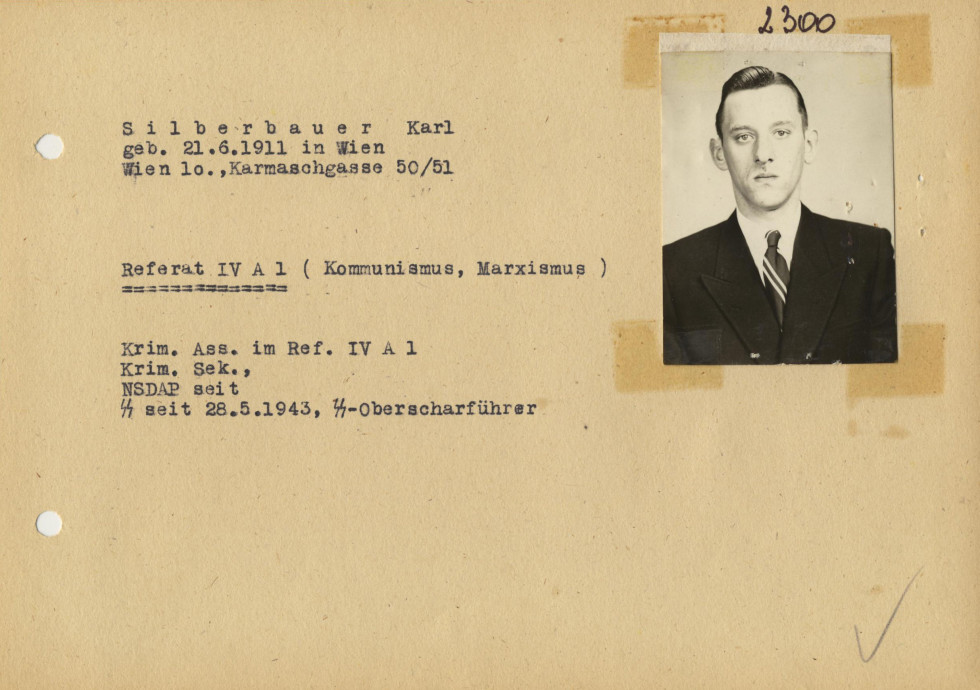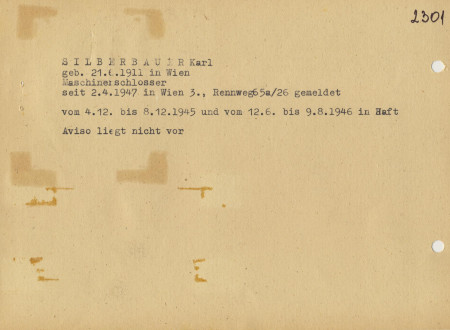Employee Card of SS-Oberscharführer Karl Josef Silberbauer
An Unexpected Finding
After two years of hiding in the attic of an old Amsterdam house, members of the Jewish Frank family and their fellow fugitive companions were arrested on August 4, 1944. On September 3, all of them were sent to Auschwitz, from where Anne and Margot were in October 1944 sent to Bergen-Belsen concentration camp, where they died in March 1945.
The man who made the arrest was a native of Vienna, the SS-Oberscharführer (senior sergeant) Karl Josef Silberbauer (1911-1972), an employee of Gestapo and Sicherheitsdienst in the occupied Netherlands. He had worked for the Austrian police until 1935 and was after the Anschluss employed by the Gestapo in its section V A 1 to fight communism and Marxism (evident also from the document published here). In 1943, he was sent to the Netherlands, where he was mostly involved in Gestapo’s anti-Semitic activities (section IV B 4).
Karl Silberbauer, a lower-ranking SS member, sparked the interest of the world public twice in his post-war years. He first became the object of interest when Anne Frank’s published diary gained popularity in the early 1950s. However, the publishing of her diary made those who denied any existence of the holocaust doubt the diary’s authenticity, claiming that it was a forgery and that Anne Frank was a fictitious character.
But Simon Wiesenthal proved them wrong when in 1963 he located Karl Silberbauer. Immediately admitting that he was the one who arrested Anne Frank and even remembering a number of details of this particular arrest of Otto Frank’s family, Silberbauer had since 1954 again worked as a criminal police inspector in Vienna. During the investigation of his wartime activities, he was temporarily suspended from his police post and only allowed to come back after Otto Frank testified that the arrest of his family had been made correctly and without any use of force. Despite the information that Silberbauer was imprisoned for a while after the war (found guilty of brutal questioning of the members of German Communist Party), the image of Silberbauer as described by Otto Frank is an image of a diligent, cold and rational executioner of tasks assigned to him, a type of official similar to the one described by Hannah Arendt in her texts on the “banality of evil”.
This year the name Karl Silberbauer is encountered again, as a character in the book by Peter-Ferdinand Koch titled Enttarnt. Doppelagenten: Namen, Fakten, Beweise. The book tells a familiar story that takes place during the Cold War, when West German intelligence service drafted former Nazis, among them also Silberbauer, to work as their agents for their anti-communist and resurfacing anti-Nazi operations.
The document published here as this month's archivalia (Silberbauer’s Gestapo employee card) is kept at the Archives of the Republic Slovenia among the records of the fonds AS 1931, Republic Secretariate of the Interior of the Socialist Republic of Slovenia. Preserved in this extensive fonds are records on public and state security that were created, received or gathered in the course of the work of the ministry (secretariate) and all its subordinate structures. Apart from the records of the Slovenian war and post-war communist intelligence service and political police (VOS, OZNA, UDV, USDV), which comprise most of the fonds and include some very interesting documents on Slovenian history of the 20th century, the fonds also includes the so called trophy Italian and German war records. Original German records (post-war reconstructions exist as well; both were collected and until 1991 kept by the archive and documentation department at UDV/USDV) mostly have to do with confiscating material from retreating German troops (so called war booty). We still have no exact data on the origin of the four boxes of Gestapo Wien documents, which are included among the original German records and contain personal cards of employees of all Gestapo Wien departments, with post-war inscriptions written at the back of each card.
Tadej Cankar



